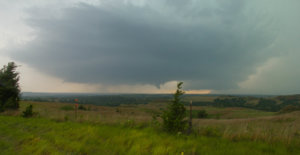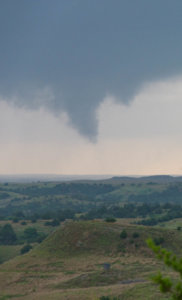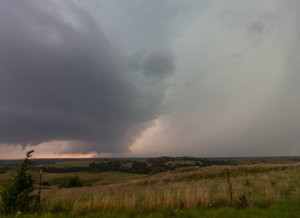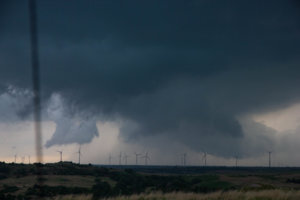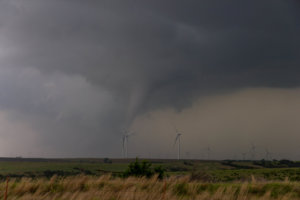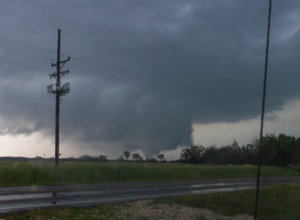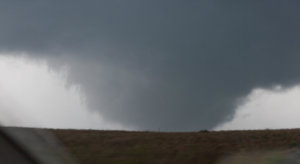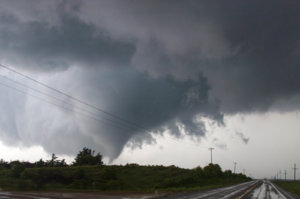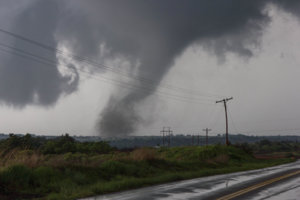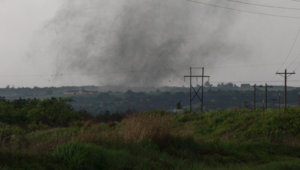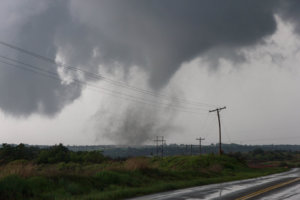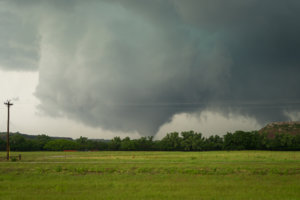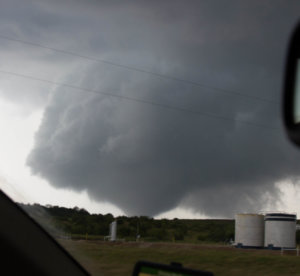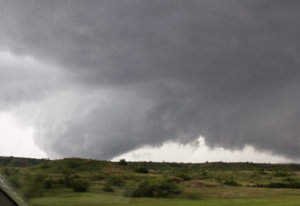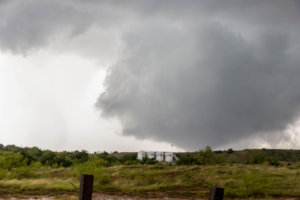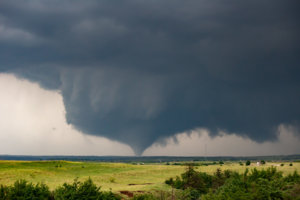Good day all,
Below is my late-posting of this chase log for May 18. I was also chasing with Derek Sibley on this chase.
Summary: On May 18, we woke up to a high-risk chase day, expecting a major tornado outbreak in Oklahoma. By the end of the day, it turned out to be more or less mediocre day for chasing with more messy storm development instead of discrete supercells. We forecasted and left Oklahoma City during the morning and headed west to near El Reno on I-40, then Highway 270 to the preliminary target area of Woodward, Oklahoma, stopping there to look at data and for lunch. By 1630z, the SPC had much of NW Oklahoma and SW Kansas in a high-risk outlook. Tornado probabilities were 30%, wind at 30%, and hail at 45%, ALL hatched for significant. By early afternoon, SPC issued MCDs 756 and 758, and subsequent PDS (particularly dangerous scenario) tornado watch boxes 235 and 239 for the area, valid until 8 and 11 PM CDT, respectively. From early afternoon, it became apparent that convection was developing from south to north in a weakly capped environment, which is bad for a good chase. The result was a messy cluster of storms everywhere by late afternoon, with tornadic supercells embedded in areas with better air to work with, not the fearful long track violent tornadoes expected by many.
The chase took us out of Woodward to west of town near Fargo and Fort Supply, then north on 183 to 64 east out of Buffalo and to near Alva. Two tornadic supercells were encountered there, one rain wrapped near Alva, and another classic one with a tornado near Avard and NE of Waynoka off Highway 281. We backed up 281 to Alva and back west on 64 to SR 14, then south to reach 281 and all the way to Seiling, then continued south via 183 to near Custer City, and west on SR 33 to check convection near there. We wrapped up the chase via 33 back to 183 south to Clinton, meeting several other chasers (including Ben with Weather Nation and Tim Marshall) for dinner. I did an interview there as well for Weather Nation. After dinner, we spent the night in Clinton, Oklahoma.
1). May 18, 3:00 PM - Interception and observation of a very severe thunderstorm from near Fargo, Oklahoma to Fort Supply in Harper County, and along SR 46 to Highways 64 and 183. The storm was a classic to HP supercell thunderstorm. A rotating wall cloud was observed with this storm, but it quickly evolved to a line segment and weakened due to storms developing south and southeast of it. Conditions encountered were heavy rains, frequent lightning, 60 MPH winds, and small hail. The main core was not penetrated. Conditions causing the storm were surface heating, a dryline, a low pressure area, and upper trough. A 2016 Jeep Wrangler was used to chase the storms. Documentation was digital stills and HD video. A PDS (particularly dangerous scenario) tornado watch was also in effect for the area until 8 PM CDT.
2). May 18, 4:30 PM - Interception and penetration of a very severe and tornadic thunderstorm in Woods County, Oklahoma near Camp Houston along Highway 64. The storm was an HP supercell storm with a possible rain-wrapped tornado in progress as it was penetrated from the west. A funnel cloud developing and disappearing into rain was observed, with an area of strong rotation / dust being lofted as the weak tornado developed and lifted north (in poor visibility). Hail to 1", strong winds to 60 MPH, very heavy rains, and frequent lightning was also observed when penetrating this storm. Conditions causing the storm were surface heating, a dryline, a low pressure area, and upper trough. A 2016 Jeep Wrangler was used to chase the storms. Documentation was digital stills and HD video. A PDS (particularly dangerous scenario) tornado watch was also in effect for the area until 8 PM CDT.
3). May 18, 5:15 PM - Interception and observation of an extremely severe and tornadic thunderstorm in Woods County, Oklahoma along Highway 281 and between Avard and Waynoka. The storm was a classic and cyclic supercell storm. A large cone (or even wedge tornado) was observed with this supercell looking southwest from near Avard. The tornado evolved to multi-vortex and then a large wall cloud. Another wall cloud and large funnels developed as the storm cycled. The funnel formed from the new mesocyclone while the tornado near Waynoka was still in progress. The storm also had a very striking visual appearance (with "stacked plates" presentation). This supercell evolved to LP through downscale growth and weakened northwest of Alva. The storm core was not penetrated (contained at least 2" hail), but light rains, 40 MPH winds (inflow), and frequent lightning was observed. Conditions causing the storm were surface heating, a dryline, boundary interactions, a low pressure area, and upper trough. A 2016 Jeep Wrangler was used to chase the storms. Documentation was digital stills and HD video. A PDS (particularly dangerous scenario) tornado watch was also in effect for the area until 8 PM CDT.
4). May 18, 6:30 PM - Interception and observation of a severe thunderstorms from west of Custer City and near highway 183 and SR 33 west of Putnam and Arapaho in Dewey and Custer Counties. The storm was a multicell cluster of strong and severe storms, formed by two supercells evolving to HP and merging ahead of the dryline. A large funnel was observed on the forward flank of the storms west of Putnam, as well as a large shelf cloud towards the southern portion of the storm complex. The cores were not penetrated. Frequent lightning, heavy rains, and 45 MPH winds were encountered. Conditions causing the storm were surface heating, a dryline, a low pressure area, and upper trough. A 2016 Jeep Wrangler was used to chase the storms. Documentation was digital stills. A PDS (particularly dangerous scenario) tornado watch was also in effect for the area until 8 PM CDT.
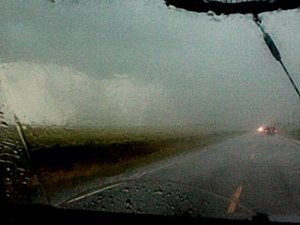 Above:
Above: Possible rain-wrapped tornado to the west and northwest of Alva, Oklahoma on May 18. The tornado would be to the left in this picture. The view is to the east.
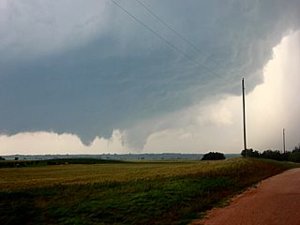 Above:
Above: First view of the Waynoka tornado from near Avard, Oklahoma looking to the west and southwest during the afternoon of May 18. The tornado, although weakening, is in the center of this picture. The next storm "cycle" is to the left of that (funnel / rotating wall cloud).
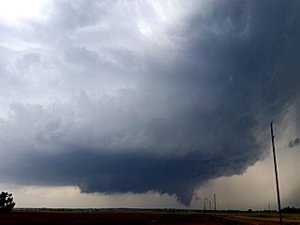 Above:
Above: New rotating wall cloud / funnel near Avard on the Waynoka cyclic supercell. The storm was classic structure, with a striking visual appearance.
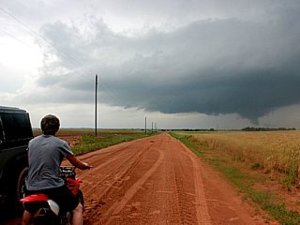 Above:
Above: Funnel and supercell structure with a teenager (from a local farmstead riding his dirtbike) watching it. The view is to the west near Avard, Oklahoma.

